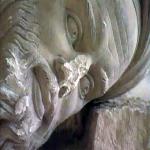31 March 2010

Photo: VOA
For three days in April 2003 looters rampaged in the store rooms and galleries of Iraq's National Museum, making off with some 15,000 priceless objects. Art historians call it the desecration of civilization.
Seven years ago, in the chaos that followed the U.S. invasion of Iraq and the fall of Saddam Hussein, looters ransacked Iraq's National Museum. Donny George Youkhanna, at the time the museum's director general, witnessed the looting and is haunted by the memroies. He fled Iraq in 2006 and has been teaching at a university outside New York City.
Art historians call it the desecration of civilization. For three days in April 2003 looters rampaged in the store rooms and galleries of Iraq's National Museum, making off with some 15,000 priceless objects. Many dated back thousands of years, to the great civilizations of Babylon and Mesopotamia.
Donny George Youkhanna, then director general of the museum, remembers it well.
"We had them here, single items unique for the history of mankind. They were there in that museum. And then, some of them completely destroyed, some of them looted, gone. When I remember, deep inside myself, I feel my heart bleeding for that," he said.
Youkhanna, who fled Iraq at the height of the insurgency, is teaching anthropology at a university near New York City.
In his absence, the museum was restored with major donations from the U.S. and Italy. About half of the objects that were stolen or misplaced were located and retrieved by Iraqi and American investigators.
Last year, to much fanfare, the museum re-opened, although much of the exhibition space is still closed and only special groups can visit.
Prime Minister Nouri al-Maliki officiated.
At the time, Youkhanna said re-opening the museum was premature. He said the museum was being re-opened for political reasons.
He still expresses anger over what happened seven years ago.
Coalition forces, he says, had parked a tank a few blocks away from the museum. He says he asked to have the tank moved to the museum entrance, but American troops had no order to intervene and stood by as Iraq's heritage was plundered.
One memorable moment that week was when then Secretary of Defense Donald Rumsfeld dismissed the looting in Baghdad as unimportant. "Freedom's untidy, and free people are free to make mistakes and commit crimes and do bad things," Rumsfeld said.
Youkhanna says many of the looters knew which objects they were looking for and where to find them. In other words, they were insiders. On Sunday, April 12 Youkhanna returned to the museum to survey the damage. "It's a great shock," he stated. "The word "anger" is not enough."
Fast forward to today, and a slide presentation Youkhanna gave at a New York museum. "That Sunday when we came back to the institution this is what we found. Over 120 rooms were trashed like this and everything was taken away, all the doors were smashed and papers were here and there," he said.
Fortunately, some of the most precious items had been removed from the museum ahead of the invasion, like the famous Golden Lyre of Ur, over 4,500 years old.
"Before that time we had evacuated the real gold head," Youkhanna said. "We had the bronze head there, so they took the bronze head. The gold head was in the Central Bank of Baghdad. "
Still many valuable pieces remain missing. The FBI lists "The Lioness and the Nubian," an eighth century BC ivory plaque, as the "Most Wanted" work of art in the world.
"It's inlaid with precious stones and gilded in some parts," Youkhanna explained. "That one was actually one of the masterpieces of the museum."
Today, anyone can view the museum on the Internet. Italian curators inaugurated a virtual museum last year. But the worldwide search continues, with the goal of showing the real treasures, together, in Baghdad one day.